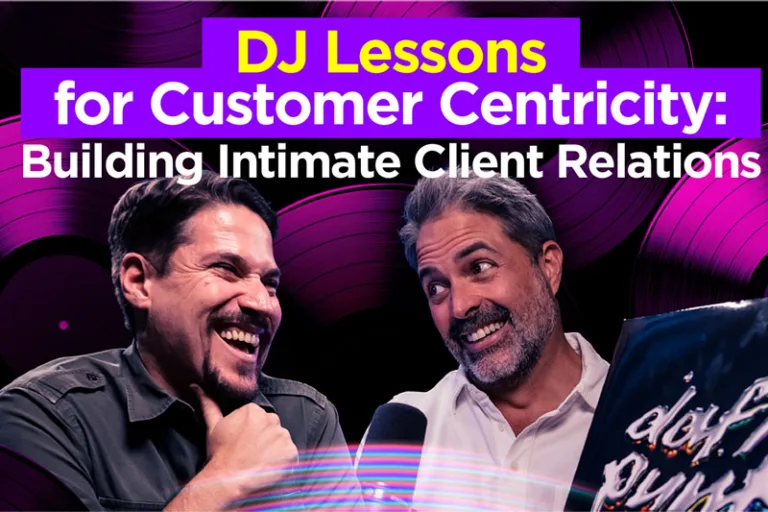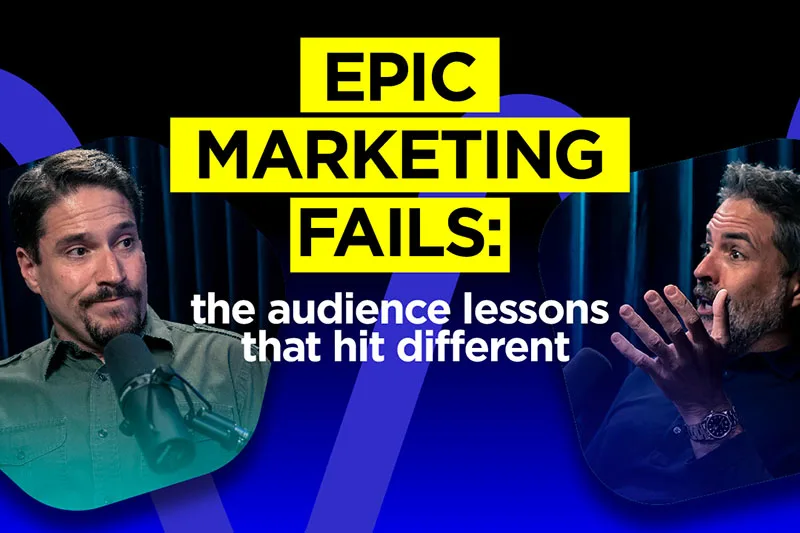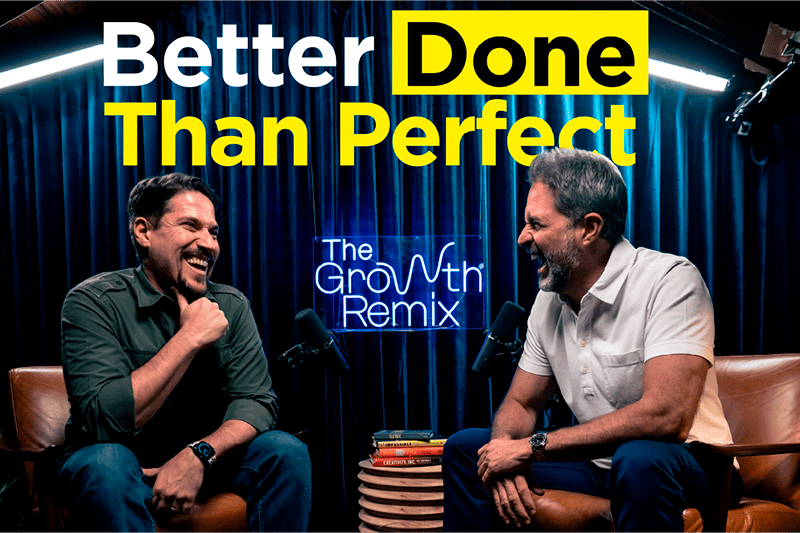Episode 4 of The Growth Remix reveals how nightclub floors teach the deepest lessons about understanding your customers’ needs.
The connection between a DJ reading an empty dance floor and an entrepreneur understanding customer pain points isn’t immediately obvious. But for Carlos Cobián, co-founder of Gravital Agency, those late nights in Ibiza starting in 1996 became the foundation for one of the most sophisticated approaches to customer centricity in modern business.
“If when I was playing it was tough and you had to be very creative, you had to cater to the customer,” Carlos reflects in Episode 2 of The Growth Remix. “Those nights when there were those five people, I told myself this is gonna be a long night, but I needed those five people to leave and tell others how amazing the club was, even though it wasn’t packed.”
The Empty Dance Floor Principle
The parallel between an empty nightclub and a struggling business is striking. In both scenarios, success isn’t about the circumstances you’re given—it’s about your ability to understand and respond to your audience’s needs, even when that audience seems disinterested or absent.
Carlos describes asking bartenders for shots of tequila before particularly challenging nights, not to escape the situation, but to mentally prepare for the extra effort required. “It was counterintuitive because people say, ‘Oh, tonight’s going to be shit, so whatever,’ but for me it was like, ‘No, I need these five people to leave here and say how amazing the club was.'”
This mindset shift—from resignation to determined customer focus—represents the foundation of authentic customer centricity that many businesses fail to achieve.
Beyond Demographics: Understanding What Makes Customers Tick
André Carlo expands on this concept, emphasizing the difference between surface-level customer knowledge and deep understanding. “Any marketing strategy has to be fundamentally customer-centric, client-centric at an obsessive level,” he explains. “It sounds nice, but when you implement it, you have to know them super well and become obsessed with knowing them at a very intimate, personal level.”
This goes far beyond traditional demographic data. True customer centricity requires understanding:
- What drives their decisions (motivations)
- What keeps them awake at night (pain points)
- What they aspire to achieve (goals)
- How they prefer to communicate (style)
- What captures their attention (engagement patterns)
The Product vs. Problem Paradox
One of the episode’s most powerful insights addresses a common entrepreneurial trap: building solutions before fully understanding problems. Carlos and André discuss clients who request specific solutions—like mobile apps—without considering whether those solutions address their actual needs.
“A client says, ‘I need an app.’ I can charge for the app, I can make the app and charge 10, 15, 20 thousand dollars for the app, but you don’t need the app,” Carlos explains. “There’s a conflict because you say I can make the app, I can bill for it, but he doesn’t need it.”
This scenario illuminates the tension between short-term revenue and long-term customer success. Companies focused on genuine customer centricity must sometimes say no to immediate opportunities to serve the customer’s actual needs.
The Henry Ford Innovation Framework
The conversation references Henry Ford’s famous observation about customer requests: if he had asked people what they wanted, they would have said “a faster horse” rather than an automobile. This principle highlights a crucial aspect of customer centricity—sometimes customers need education about solutions they haven’t yet imagined.
The key is balancing customer input with market insight. As André notes, “It’s important to listen to your customer, understand them well, but there’s also an opportunity to look at them from the outside and educate and guide them. Education is critical.”
Amazon’s Customer Intimacy Masterclass
The discussion turns to Amazon as a prime example of customer-obsessed business philosophy. Andre references Jeff Bezos’s commitment to customer experience investment, even when board members questioned the budget allocation.
Amazon’s approach demonstrates customer centricity through:
- Frictionless return policies that eliminate purchase anxiety
- Authentic user reviews that provide honest product feedback
- Detailed product information that replaces physical store examination
- Predictive recommendations based on customer behavior patterns
These elements create what André calls “customer intimacy”—a level of understanding that anticipates needs before customers articulate them.
The “Customer Is Always Right” Myth
Episode 2 tackles one of business’s most persistent myths with nuanced analysis. “Sometimes yes, sometimes no,” André responds when asked about this principle. “If you’re client-facing like us, you obviously have to listen, be empathetic, and truly understand.”
The key distinction lies between customer empathy and customer compliance. True customer service involves:
- Active listening beyond just words to understand emotions and underlying concerns
- Empathetic response that acknowledges the customer’s perspective
- Educational guidance when customer requests don’t align with their actual needs
- Respectful redirection toward more effective solutions
The Mirroring Technique for Client Understanding
Carlos shares a practical technique for managing difficult client situations: mirroring. “When you repeat back to them out loud what they’re asking for, they automatically say ‘No, no, no, that’s not what I want’ or ‘That’s not what I meant to say,'” he explains.
This technique serves multiple purposes:
- Ensures accurate understanding of client requests
- Helps clients clarify their own thinking
- Demonstrates active listening and engagement
- Creates space for collaborative problem-solving
Customer Intimacy as Competitive Advantage
The concept of “customer intimacy,” borrowed from Jorge Rodríguez of Pacífica, represents the deepest level of customer centricity. This approach transforms vendor relationships into genuine partnerships.
At Gravital Agency, this philosophy manifests in their core value of partnerships. “Our relationship with our clients has to go beyond simply providing a service—it’s a partnership where we’ll be there in good times and not-so-good times,” André explains.
This commitment extends to supporting clients through financial difficulties, maintaining relationships beyond contractual obligations, and prioritizing long-term success over short-term revenue.
Practical Implementation: From Philosophy to Practice
The episode provides concrete strategies for implementing customer centricity:
1. Obsessive Problem Focus Instead of leading with product features, identify and address specific customer pain points. If customers are “pulling the product from your hands” rather than being sold to, you’ve identified genuine market need.
2. Empathy-Driven Content Strategy Develop content that directly addresses customer questions, concerns, and aspirations. Entertainment value should enhance, not replace, genuine utility.
3. Partnership Mentality Structure client relationships as long-term partnerships rather than transactional service provisions. This includes supporting clients through difficulties and maintaining relationships beyond immediate profitability.
4. Educational Leadership Guide customers toward solutions they need, even when those solutions differ from their initial requests. This requires courage and long-term thinking.
The Growth Mindset Connection
Andre emphasizes that every challenging client interaction represents a learning opportunity. “I see everything as an opportunity to learn. That’s the growth mindset. If I made a mistake, we had a very negative experience, what did we learn from this and how can we improve?”
This perspective transforms customer difficulties from frustrations into competitive advantages, as each challenging situation develops the empathy and problem-solving skills necessary for deeper customer understanding.
Beyond Customer Service to Customer Partnership
The episode concludes with a fundamental redefinition of customer relationships. Rather than viewing clients as revenue sources or service recipients, true customer centricity creates partnerships where both parties invest in mutual success.
This approach requires significant mindset shifts:
- From selling products to solving problems
- From managing transactions to building relationships
- From serving customers to partnering with them
- From short-term revenue to long-term value creation
The Competitive Reality
In today’s marketplace, customer centricity isn’t optional—it’s survival. Companies that master the art of truly understanding and serving customer needs create sustainable competitive advantages that can’t be easily replicated.
As Carlos learned from those early nights in empty Ibiza clubs, success isn’t about the conditions you’re given—it’s about your ability to understand your audience so deeply that you can create experiences they didn’t even know they needed.
The Growth Remix continues to demonstrate that the most powerful business strategies often emerge from unexpected sources. Whether it’s a DJ booth or a boardroom, the principle remains constant: obsessive focus on understanding and serving your audience creates the foundation for sustainable growth and genuine partnership.


